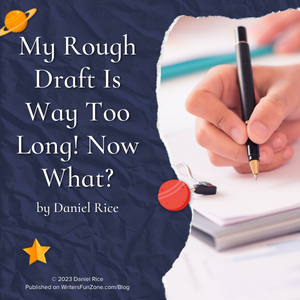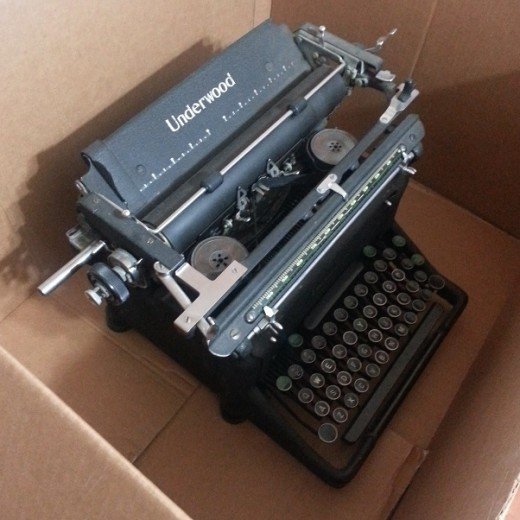My Rough Draft Is Way Too Long! Now What? by Daniel Rice
 Let’s welcome back Daniel Rice as he shares with us “My Rough Draft Is Way Too Long! Now What?” Enjoy!
Let’s welcome back Daniel Rice as he shares with us “My Rough Draft Is Way Too Long! Now What?” Enjoy!
***
Have you ever encountered the issue of too many words in your rough draft?
I have, more than once. I used to dread having to chop away the excess words.
They represented subplots, nuance, world-building, telling details, etc. They were my imaginative thoughts, and I didn’t want to sacrifice a single one.
If that sounds like you, the best thing to do is rip off the Band-Aid.
Cut, chop, and hack away at the editorial butcher block until all the fat is trimmed from the manuscript.
The Issue
Most of this is a mindset issue.
As writers, we typically love our work and the act of creating it. Otherwise, why would anyone spend dozens, scores, hundreds of hours bleeding their heart and soul into something?
Especially when for many of us, the reward is very little beyond the satisfaction of a job well done.
So tear off the bandage. Remember, those early drafts are meant to be edited and rewritten. That’s the writer’s life.
My Own Books
The first two books in The Allison Lee Chronicles came in at about 87,000 words, near the sweet spot for young adult fantasy.
I edited the heck out of those books, but I didn’t have to cut tens of thousands of words to reach the final word count.
However, the rough draft of the third novel came in at nearly 130,000 words.
Yikes! I had a monumental editorial job. I needed to butcher the manuscript.
You might think cutting about 40,000 words from a draft is a painful process. In truth, it wasn’t.
At least, not after I overcame the initial mental hurdle that I had set an enormous task for myself.
So how did I go about chopping away those words?
The High-Level Read-Through
First, I did a high-level read-through of the draft, using Word’s comment function to note chapters and subplots that should be cut, consolidated, or built up.
Next, I started cutting chapters and subplots.
If I loved the writing or figured I might be making a mistake, I’d paste the words into a separate file in case I needed to retrieve them later.
In practice, I have never reconstituted chapters or subplots I have purposely cut.
Once I’ve cut away the excess, I switch to consolidation.
The Consolidation
Believe me, when you need to sacrifice 40,000 words, the trick is to consolidate, consolidate, consolidate.
Sometimes I combined as many as three chapters into one streamlined chapter.
The key is to keep asking yourself if you’re telling the tale in the most efficient way possible without sacrificing your voice and the overall drama of the storyline.
This can be hard, especially for new writers. But that’s okay. It becomes easier with practice.
Just remember, at the end of the day, it’s a mindset thing: the rough draft is meant to be edited and rewritten.
Only once I’m done with all the cutting and rewriting to trim back the word count will I fill in subplots and scenes that I felt were given short shrift in the rough draft.
This can have the side effect of ballooning the word count. Hopefully not, but it’s possible.
If the story grows too much, you may need to consider dropping another subplot, but that’s not a given.
Paragraph and Sentence-Level Editing
Once all the scenes and subplots are shipshape, it’s time to get down to the paragraph and sentence-level editing.
This level of editing will often subtract a few thousand more words from the manuscript.
When it comes to cutting words, mindset is the key.
Excess words aren’t inherently bad, but they need to be cut. Chop off the fat. Restructure multiple chapters into streamlined ones. And finally, edit those sentences to as close to perfection as humanly possible.
Ultimately, you might find you have a far better manuscript than you imagined possible.
Resources
About The Blood of Faeries
 Allison wilts under the bright light of celebrity after being exposed as a shape-shifting monster. She wants everything to go back to the way things were. But, after she accidentally kills a man sent to kidnap her, she realizes piecing her old life back together is one gnarly jigsaw puzzle.
Allison wilts under the bright light of celebrity after being exposed as a shape-shifting monster. She wants everything to go back to the way things were. But, after she accidentally kills a man sent to kidnap her, she realizes piecing her old life back together is one gnarly jigsaw puzzle.
***
ABOUT THE AUTHOR
 Dan Rice pens the award-winning young adult urban fantasy series The Allison Lee Chronicles in the wee hours of the morning. Kirkus Reviews calls his novel The Blood of Faeries “…a wild, riveting ride.”
Dan Rice pens the award-winning young adult urban fantasy series The Allison Lee Chronicles in the wee hours of the morning. Kirkus Reviews calls his novel The Blood of Faeries “…a wild, riveting ride.”
To learn more, visit his website: https://www.danscifi.com and join his newsletter.






